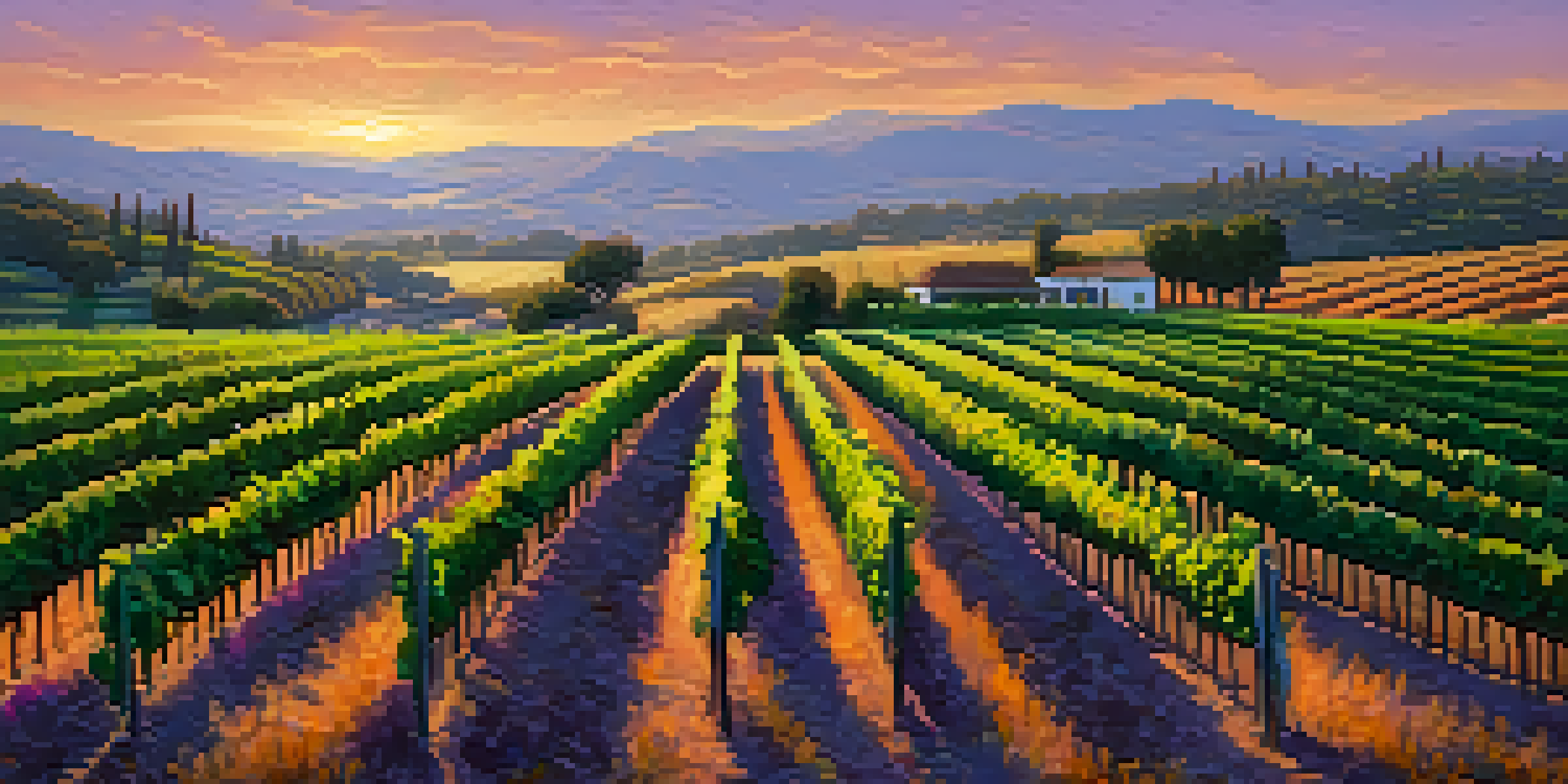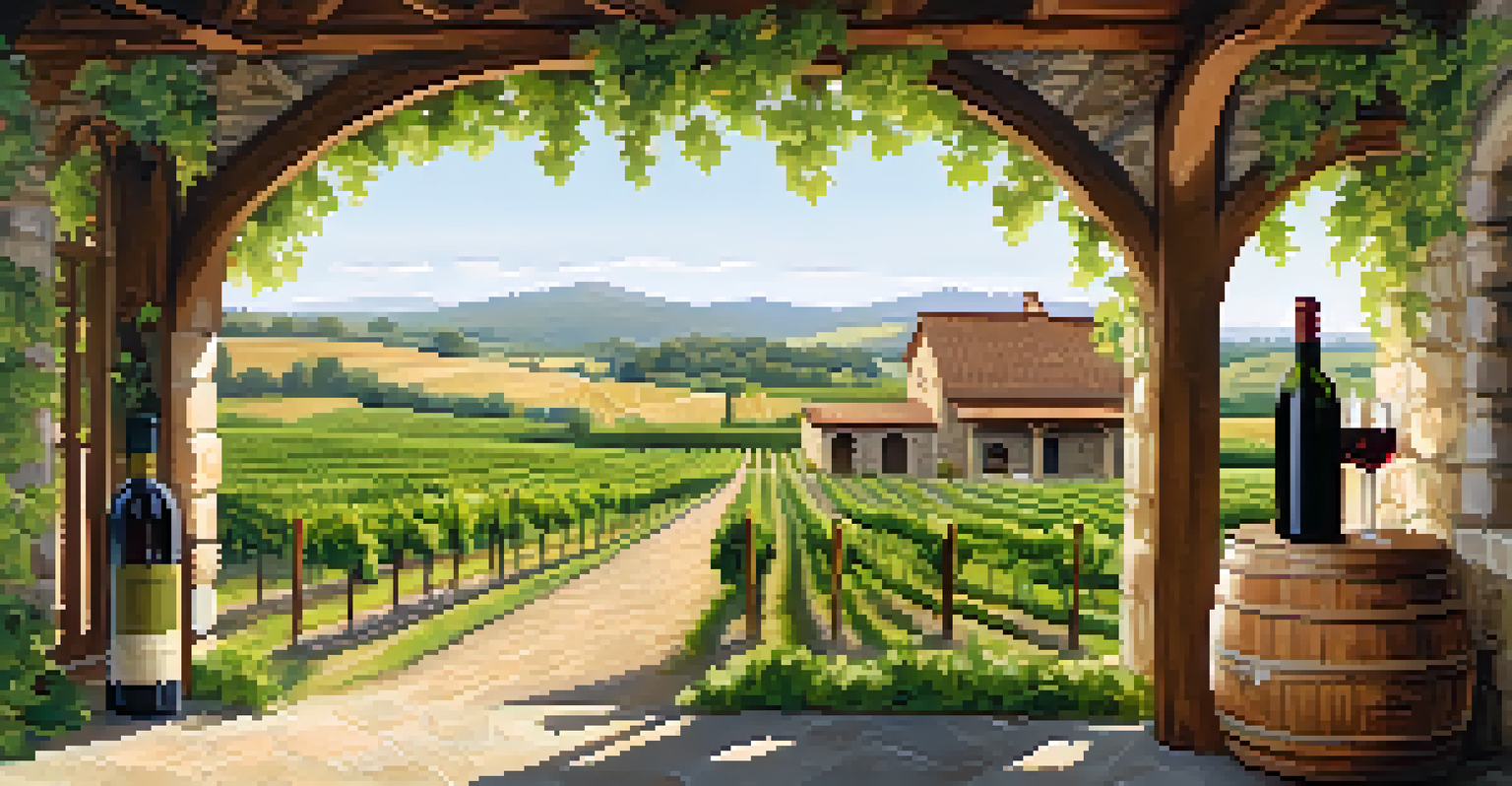Wine Tourism: California's Global Influence on Wine Culture

The Rise of California as a Wine Destination
California has emerged as one of the world's premier wine destinations, attracting millions of visitors each year. With its diverse climates and rich soil, regions like Napa Valley and Sonoma County have become synonymous with high-quality wine production. This rise can be traced back to the late 20th century when innovative winemakers began to redefine American wines on the global stage.
Wine is sunlight, held together by water.
Tourists flock to California not just for the wine but for the entire experience—vineyard tours, tastings, and picturesque landscapes. It's a place where wine lovers can immerse themselves in the culture, learning about the winemaking process firsthand. This immersive experience has positioned California as a leader in wine tourism, influencing how other regions develop their wine industries.
Moreover, California's success has inspired many emerging wine regions around the world to adopt similar practices. From marketing strategies to vineyard management techniques, the Golden State's influence on global wine culture is undeniable. As more travelers seek out unique wine experiences, California's impact will continue to resonate worldwide.
The Role of Wine Festivals in Promoting Tourism
Wine festivals play a crucial role in attracting tourists to California's vineyards. Events like the Napa Valley Wine Auction and Sonoma County Harvest Fair showcase local wines while providing entertainment and cultural experiences. These gatherings not only celebrate the local wine heritage but also offer visitors an opportunity to taste a variety of wines in one place.

Throughout the year, these festivals draw wine enthusiasts from across the globe, creating a vibrant atmosphere filled with tastings, pairings, and live music. They also promote community spirit, as local winemakers come together to share their passion with attendees. This sense of camaraderie enhances the overall experience, making it memorable for visitors.
California: A Global Wine Hub
California has become a leading wine destination, attracting tourists with its exceptional wine experiences and vibrant vineyard culture.
Additionally, wine festivals serve as a platform for sustainable practices and education. Many events highlight eco-friendly wines and innovative winemaking techniques, appealing to a growing demographic of environmentally conscious consumers. As the wine tourism scene evolves, festivals will remain a pivotal element in connecting wine culture with broader social values.
How Wine Tourism Supports Local Economies
Wine tourism significantly boosts local economies, providing jobs and promoting local businesses. The influx of visitors supports not only wineries but also hotels, restaurants, and shops, creating a ripple effect throughout the community. In regions like Napa Valley, wine tourism has become a vital economic driver, helping sustain local livelihoods.
In wine, there is truth.
Moreover, many wineries invest in their communities, contributing to infrastructure improvements and local initiatives. This investment fosters a sense of pride among residents and enhances the overall visitor experience. Tourists often seek authentic local experiences, making it essential for wine regions to showcase their unique cultures and traditions.
As a result, wine tourism creates a symbiotic relationship between the wine industry and the local economy. When tourists spend money on wine, food, and experiences, they help to strengthen the community. This collaboration is crucial for the long-term sustainability of both the wine tourism industry and the regions it supports.
Cultural Exchange Through Wine Tourism
Wine tourism fosters cultural exchange, connecting people from diverse backgrounds through a shared love of wine. Visitors to California often learn about the winemaking traditions and practices that reflect the region's history and heritage. This exchange enriches the experience for both tourists and locals, creating lasting memories and connections.
Many wineries offer educational tours that delve into the science of viticulture and the art of winemaking. These experiences not only inform visitors but also instill a deeper appreciation for the craft. As tourists share their own cultural perspectives, the dialogue around wine becomes more vibrant and multifaceted.
Wine Festivals Boost Tourism
Events like wine festivals enhance tourism by showcasing local wines and creating memorable experiences that celebrate community and culture.
Furthermore, California's wine culture has incorporated various global influences, making it a melting pot of flavors and practices. This blend of traditions enriches the local wine scene and encourages a broader understanding of wine's role in different cultures. As wine tourism continues to grow, the potential for cross-cultural connections only expands.
Sustainability Practices in California's Wine Industry
Sustainability has become a cornerstone of California's wine tourism, with many wineries adopting eco-friendly practices. From organic farming to water conservation, the industry is increasingly focused on minimizing its environmental impact. Tourists are drawn to wineries that prioritize sustainability, as they seek responsible consumption experiences.
Many California wineries have embraced certifications such as California Sustainable Winegrowing and organic practices, demonstrating their commitment to the environment. This focus not only appeals to eco-conscious travelers but also ensures the long-term health of vineyards and surrounding ecosystems. As more visitors become aware of these efforts, sustainability becomes a key selling point in wine tourism.
By integrating sustainable practices into their operations, wineries contribute to a larger movement toward environmental responsibility within the tourism sector. This shift encourages consumers to make informed choices when it comes to wine consumption. Ultimately, sustainability in California's wine culture serves as a model for other regions aiming to balance tourism with environmental stewardship.
The Influence of Technology on Wine Tourism
Technology has transformed the wine tourism experience, making it more accessible and engaging for visitors. Online booking platforms and virtual tastings have opened new avenues for wine enthusiasts to connect with vineyards. This accessibility has expanded the reach of California's wine culture to a global audience, allowing people to explore wines from their own homes.
Social media also plays a significant role in promoting wine tourism. Wineries leverage platforms like Instagram and Facebook to share stunning visuals and stories that draw in potential visitors. These digital marketing strategies create a sense of community among wine lovers, encouraging them to share their experiences and recommendations.
Sustainability Drives Wine Tourism
The adoption of eco-friendly practices in California's wineries is appealing to tourists seeking responsible consumption and environmental stewardship.
Moreover, advancements in mobile apps allow tourists to navigate wine regions with ease, providing information on wineries, events, and even personalized recommendations. As technology continues to evolve, it will further shape the future of wine tourism, enhancing the connection between consumers and the rich culture surrounding California wines.
Future Trends in California Wine Tourism
As wine tourism continues to grow, several trends are emerging that will shape its future in California. One notable trend is the increasing demand for experiential travel, where visitors seek unique and memorable experiences rather than just tastings. This shift encourages wineries to innovate and offer one-of-a-kind activities, such as blending workshops or vineyard dinners.
Another trend is the rise of wellness tourism, with travelers looking for ways to unwind and rejuvenate while enjoying wine. Many wineries are responding by offering wellness retreats, featuring yoga sessions and spa treatments amidst the vineyards. This fusion of relaxation and wine appreciation is appealing to a broader audience seeking holistic experiences.

Finally, the focus on local and sustainable food pairings will continue to influence wine tourism. As consumers become more interested in where their food comes from, wineries that emphasize farm-to-table experiences are likely to thrive. This trend not only supports local agriculture but also enhances the overall tasting experience, allowing visitors to savor the full richness of California's wine culture.